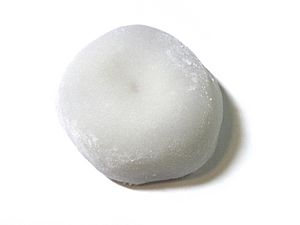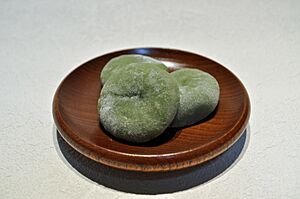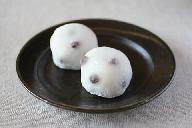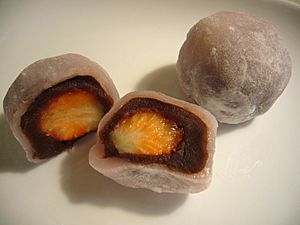Daifuku facts for kids
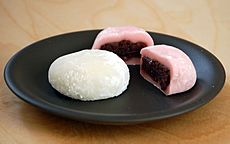 |
|
| Alternative names | Daifukumochi (Kōhaku type) |
|---|---|
| Place of origin | Japan |
| Region or state | East Asia |
| Main ingredients | glutinous rice, sweet filling (usually red bean paste) |
| Variations | Yomogi daifuku, Ichigo daifuku, Yukimi Daifuku |
Daifukumochi (大福餅), or Daifuku (大福), is a super popular Japanese sweet treat! The name "Daifuku" actually means "great luck."
It's a type of Wagashi (traditional Japanese sweets). Imagine a small, round, soft cake made from mochi, which is a special kind of glutinous rice. This soft cake is then filled with something sweet.
The most common filling is called anko. This is a sweet paste made from azuki beans. Daifuku is often enjoyed with a cup of green tea in Japan.
Daifuku comes in many different kinds! You'll often see them in white, light green, or pale pink colors. They are usually about 4 centimeters (1.5 inches) wide.
To keep them from sticking to each other or your fingers, nearly all Daifuku are lightly covered with a fine powder. This powder can be rice flour, corn starch, or potato starch.
While there's a traditional way to make mochi and Daifuku called mochitsuki, you can also make them quickly using a microwave!
The Lucky History of Daifuku
Daifuku has a fun history! It was first called Habutai mochi, which meant "belly thick rice cake." This was because of its generous filling.
Later, its name changed to daifuku mochi, meaning "big belly rice cake." But here's the cool part: in Japanese, the word for "belly" (Fuku) sounds exactly like the word for "luck" (Fuku).
So, the name was changed again to daifuku mochi, meaning "great luck rice cake"! People believed it brought good fortune. By the late 1700s, Daifuku became very popular. People even started eating them toasted and giving them as gifts for special events.
Delicious Daifuku Varieties
Daifuku comes in many exciting flavors and styles! Some versions have whole pieces of fruit inside, or a mix of fruit and anko. You might even find some covered in confectioner's sugar or cocoa powder.
Here are some popular types:
- Yomogi Daifuku: This one is made with kusa mochi, which is mochi flavored with a plant called mugwort. It gives the mochi a unique green color and earthy taste.
- Mame Daifuku: For this type, azuki beans or soybeans are mixed right into the mochi itself, or sometimes into the sweet filling.
- Shio Daifuku: This version has an unsweetened anko filling. It has a slightly salty taste, which balances the sweetness of the mochi.
- Awa Daifuku: This Daifuku is made with Awa mochi, which is mochi mixed with Foxtail millet.
- Ichigo Daifuku: This is a very popular variation that includes a fresh strawberry and sweet filling (usually anko) inside the mochi. Sometimes, cream is used as a filling too. Because it has strawberries, it's usually eaten in the spring. It was invented in the 1980s, but no one knows exactly who invented it first!
- Ume Daifuku: This type uses a sweetened Japanese apricot instead of the usual azuki sweet filling.
- Coffee Daifuku: As the name suggests, this one has a coffee-flavored sweet filling.
- Mont Blanc Daifuku: This delicious Daifuku contains a creamy, puréed, sweetened chestnut filling, similar to a Mont Blanc dessert.
- Purin Daifuku: This version features a crème caramel (pudding) filling instead of azuki paste.
- Ice Cream Daifuku: This is a cool treat where the Daifuku is filled with ice cream instead of a sweet bean paste.
See also
 In Spanish: Daifuku para niños
In Spanish: Daifuku para niños


